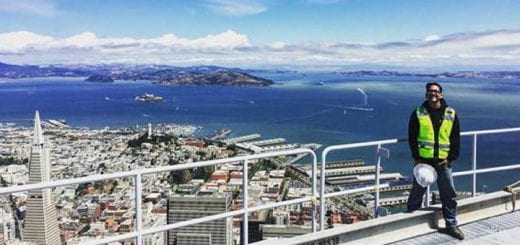The Pursuit of Greatness: SJSU’s Educational Opportunity Program

EOP staff: Alexia Lozano, Forensic Science; EOP Interim Director Teresa de la Cruz; Sophie Peregrino, Biological Sciences; and Estephanie Hernandez, Sociology. Photo: David Schmitz.
Erika Cortes’ shirt tells her story. On one side, it reads “I am EOP,” and on the other, “Born to Achieve Greatness.” As a high school student, she did not consider college a possibility until her field hockey coach encouraged her to look into an Educational Opportunity Program (EOP). Once at San Jose State, she took advantage of the program’s advising, tutoring and student support services, eventually working as a student assistant and EOP event coordinator. The first member of her family to graduate from college, Cortes wears her EOP shirt with pride.
“Yes, we are first-generation college students and, yes, we do come from low-income backgrounds, but with the help of the program and the services that come with it, we are able to achieve greatness and become successful people,” says Cortes, ’18 Political Science. “Instead of worrying about how I am going to do this or where to go, we have the resources to focus on academics. EOP is a one-stop place to develop your greatness.”
“If you can see it, you can be it. Having a program like EOP almost guarantees that our country will be stronger, our people will be wiser and the very fabric of our world will be committed to greatness. Our graduates change the world.” — Judge Robert Rigsby, ’83 Criminal Justice Administration
Creating Opportunities
Before EOP was created 50 years ago, students like Cortes did not have the same resources to apply for, attend and stay in college. The federal program was designed to create opportunities for underrepresented, low-income and first-generation college students. EOP at San Jose State originated alongside the Olympic Project for Human Rights and the growing Chicano movement. The students and members of the staff and faculty who advocated for the creation of EOP did so to open the campus up to populations that historically had been prevented from attending.
Many early EOP recruiters and volunteers partnered with local high schools to meet with students who did not meet university admissions requirements. Their goal? To break down institutional barriers to higher education and provide the services necessary to make college a reality for young people of color and first-generation college students. For five decades, San Jose State alumni and faculty and staff members have worked to recruit, prepare, retain and support students who otherwise might not have a clear pathway to a degree.
One such alumnus is Humberto Garza, ’68 Social Science, who served as chairperson of the Mexican American Student Confederation (MASC), a student organization that worked to increase outreach and opportunities for Chicanos. A Vietnam War-era veteran, Garza believed that it was unfair to expect “poor people to go to war before they could afford a college education. There had to be a better way.”
Early Beginnings
Historically, San Jose State had a “two percent rule” for students who did not meet admission requirements—typically used to recruit student-athletes, especially young men of color. Simultaneous to the Chicano movement, Olympic Project for Human Rights founders Harry Edwards, ’64 Sociology, ’16 Honorary Doctorate, and Ken Noel, ’66 BA, ’68 MA, Sociology, organized efforts to demand that the university open the door for more African-American students with potential who were not athletes. When the program was initially created at San Jose State, Chicano and African-American student leaders lobbied the administration to open more slots for incoming students in both populations. This resulted in the university awarding campus funding for two separate programs: Chicano EOP and Black EOP.
Tim Knowles, ’67 Secondary Education, was the first director of Black EOP, later handing the reins over to Glen Toney, ’71 MA Education, ’73 Mathematics. All Spartans themselves, the EOP directors wanted to create spaces where new students could find community and educational resources. By the time former student-athlete and professional football player S.T. Saffold was hired to be Toney’s assistant director in fall 1969, both EOP programs were beginning to grow. As a scholarship athlete, Saffold recognized that if EOP had existed when he was enrolled, he would have fit the profile of an EOP student.
“We needed to make students feel comfortable in what had been up until that point an uncomfortable environment,” says Saffold, ’67 Kinesiology, ’78 MA Education. “Harry Edwards, Glen Toney, Tim Knowles and Black Studies Department Chair Leonard Jeffries were among my role models. They taught me that we stand on the shoulders of others. It was our intent that those who experienced our support would continue to pay it forward.”
Saffold worked with Chicano EOP’s then director, Gabriel Reyes, ’72 Political Science, ’74 MA Mexican American Studies, to prepare underrepresented students for college and continue developing the services to keep them there.
Since EOP was still a new idea, many universities struggled with how to best meet student needs. Would each ethnicity require its own EOP? A 1972 investigation by the Health, Education and Welfare department concluded that EOP could not be divided racially. Reyes and Saffold devised a structure to merge the programs. According to Reyes, early studies of student performance showed that those enrolled in EOP earned higher grade point averages than those of similar backgrounds who were not involved in the program. In addition to offering mentors, tutors and academic advisors to assist the students in navigating the complexity of a university system, EOP reinforced the message that its students were “college material”—leaders in the making.
Seeing is Believing

Saffold, ’67 Kinesiology, ’78 MA Education, moved his granddaughter Mikayla Saffold-Collins into the dorms in August 2018. Photo: David Schmitz.
For Saffold, it was important—and remains important—that students see campus leaders who looked like them. Whenever he spotted a black student, staff member or professor, he’d acknowledge them because every acknowledgement sent a powerful message. To be acknowledged was to be seen; to be seen was to be recognized as a person worthy of attention, education and equal rights. As an undergraduate, he remembered seeing only three black faculty members on campus—and very rarely did he feel acknowledged by them. As an administrator and campus leader, he resolved to change that.
“This led to my determination to be approachable,” says Saffold. “Harry Edwards, Ken Noel, Tim Knowles, Glen Toney and Leonard Jeffries—we all felt it was critically important for us to be approachable, especially to those students we had admitted. That was positive change.”
By identifying role models across campus, EOP offered students the chance to envision career pathways that they had never considered prior to coming to San Jose State. Robert Rigsby says that without EOP he would not have become a presidentially appointed judge of Washington D.C., making history as the first sitting judge from D.C. and the first military judge in the Army to deploy full time to an active theater of war. Rigsby is a frequent guest speaker in EOP’s I Can, I Will program, which provides guidance and support for African-American and Latino men.
“Growing up in an inner city, they don’t tell you that you can go to law school,” says Rigsby, ’83 Criminal Justice Administration. “I had no intention of ever being a lawyer until I got into EOP. I didn’t know any judges or lawyers of color in Vallejo, but at San Jose State everybody said ‘you can do anything.’ Does EOP changes lives? Absolutely. Did it change my life? Absolutely.”
Despite evidence that EOP was making a measurable impact on students’ lives, throughout the 1990s and 2000s the program was vulnerable to changes in federal and state funding. This meant that EOP student services were severely limited or cut. It wasn’t until 2008, when San Jose State faculty and staff members established a task force to restore the program, identifying needs for new staff, space, an increased budget and an institutionalized EOP council, that the program began to revive. By the time Debra Griffith, ’04 MA Education, was appointed EOP director in 2010, she was determined to rebuild the program and establish a sustainable strategy for supporting and retaining students.

L-R: Marina Corrales, Jesus Jimenez, Alberto Gutierrez, Matthew Stowe, Debra Griffith, Alisa Patterson and Crystal Cooper, 2016. Photo: David Schmitz
The Future of EOP
Griffith strategized ways to create a space where students could connect with mentors, attend mandatory study skills workshops, meet with tutors and network with a community of peers. Throughout her eight years at the helm, EOP grew to 3,000 freshman and transfer students.
“I look toward the fight and struggle for equality of education,” says Griffith. “That’s what drives me. Our students deserve the best. They deserve not to feel less-than. I had to build a community, get students engaged and committed to their own success. I think the future is elevating everything we’ve done to the next level.”
Griffith has left EOP in the capable hands of her successor, Interim Director Teresa de la Cruz. She is confident that EOP is well-positioned to expand in the coming years. She need look no further than Cortes, who believes in improving access to higher education.
“In political science, we study power,” Cortes says. “People in power decide who gets what, where and how. In society sometimes decision-makers in power have to choose who the winners are and who the losers are in a given situation. A lot of people like myself—first-generation, low-income students—can end up on the losing side of things. EOP programs are very important because they can help even out the playing field. Working for the program really helped me grow and learn a lot about myself. It was very impactful on my college career and my life.”
As her shirt states, she was and will always remain EOP.



